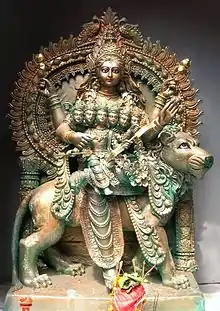Skandamata
Skandamātā (Sanskrit:स्कन्दमाता) is the fifth form of Hindu Goddess Durga. Her name comes from Skanda, an alternate name for the war god Kartikeya, and Mātā, meaning mother.[1][2] As one of the Navadurga, the worship of Skandamātā takes place on the fifth day of Navaratri. Her abode is in Vishuddha chakra.
| Skandamata | |
|---|---|
 Mother of Skanda(Kartikeya) | |
| Devanagari | स्कंदमाता |
| Affiliation | Avatar of Parvati |
| Abode | Kailash |
| Mantra | सिंहासनगता नित्यं पद्माश्रितकरद्वया। शुभदास्तु सदा देवी स्कन्दमाता यशस्विनी॥ |
| Weapon | Lotus, Two hands holding Skanda |
| Mount | lion |
| Consort | Shiva |
Symbolism
Skandamātā is four-armed, three-eyed, and rides on a lion.[3] One of her hands is in the fear-dispelling Abhayamudra position while the other is used to hold the infant form of her son Skanda on her lap. Her remaining two hands are typically shown holding lotus flowers. She is light complexioned, and as she is often pictured seated on a lotus, she is sometimes referred to as Padamasani.
Significance
It is believed that she awards devotees with salvation, power, prosperity and treasures. She can grant oceans of wisdom even to most illiterate person, if he happens to worship her. Skandamātā who possesses the brilliance of the sun fulfills all the desires of her devotees. He who is selflessly devoted to her, attains all the achievements and treasures of life. The worship of Skandamātā purifies the heart of a devotee. While worshiping her, the devotee should have absolute control over his senses and mind. He should free himself from worldly bondage and worship her with a single-pointed devotion. Her worship is twice blessed. When the devotee worships her, Lord Skand, her son in her lap, is automatically worshipped. Thus, the devotee happens to enjoy the grace of Skandmata along with the grace of Lord Skand. If a devotee worships her devoid of selfishness, the Mother blesses them with power and prosperity. The devotees who worship Skandamātā shine with divine splendor. Her worship is ultimately conducive to salvation. She is regularly known as "The Goddess of Fire".
Prayers
Mantra
ॐ देवी स्कन्दमातायै नम: Oṃ Devī Skandamātāyai Namaḥ
Dhyan Mantra
सिंहासनगता नित्यं पद्माश्रितकरद्वया. शुभदास्तु सदा देवी स्कन्दमाता यशस्विनी. Sinhasangata nityam padmashritkardvya, Shubhdastu sada Devi Skandmata Yashswini
References
- Bhāgīrthaprasāda Tripāṭhī (2000). Shakti, Shiva, and Yoga. Yagyoga Chetana Pītham. p. 60.
- Shanti Lal Nagar (1998). Indian Gods and Goddesses: Hindu, Jain, and Buddhist Goddesses. B.R. Publishing Corporation. p. 43. ISBN 978-81-7646-497-0.
- https://timesofindia.indiatimes.com/blogs/the-photo-blog/9-days-9-avatars-goddess-skandamata-teaches-us-to-love-fiercely/
- Dictionary of Hindu Lore and Legend (ISBN 0-500-51088-1) by Anna Dhallapiccola